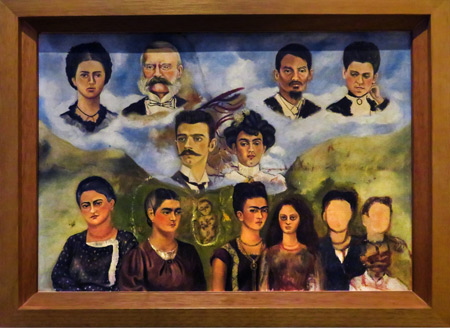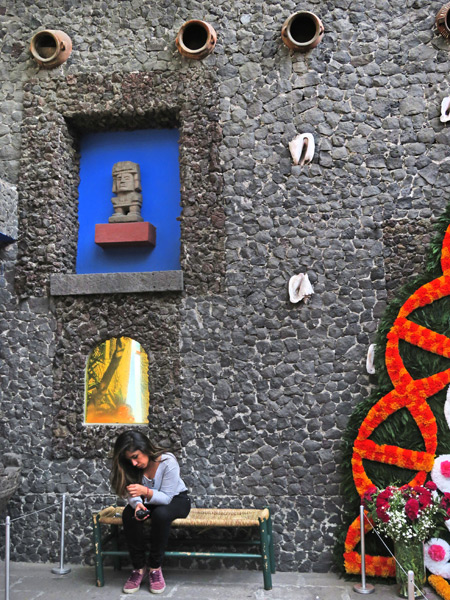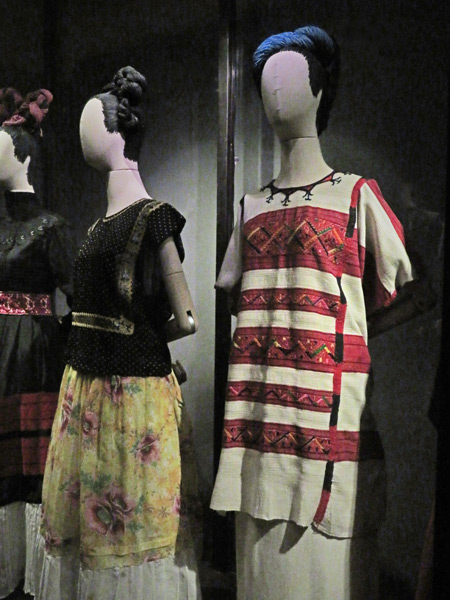Is This the Isthmus? Tour – Mexico Part 23
Friday, October 20, 2017
Mexico City, Mexico

A couple of Ciclotaxis at the Zocalo in Mexico City, Mexico.

The long line to get into the Frida Kahlo Museum in Mexico City, Mexico.
Today, I squeezed onto the super-annoying sardine-packed subway and rode it all the way down to the Coyacoan area of Mexico City to make a pilgrimage to the Frida Kahlo museum. (Pretty much everyone who visits Mexico City goes there and to the huge pyramids at Teotihuacán, so I guess that makes me a copycat.) From the subway station to the museum, it’s a very pleasant 15-minute walk through a nice, leafy “suburb” lined with plenty of fancy pants cafes and shops. Even a full block away from the museum, I could already see a bunch of people out front. Walking up closer, I was dismayed–but not really surprised–to see a line stretching across the whole front of the building and around the corner. Luckily, it only took about 30 to 45 minutes to make it inside, because closing time was just a couple of hours later.

Marxism Will Bring Health to the Sick (1954) by Frida Kahlo at the Frida Kahlo Museum in Mexico City, Mexico.

My Family (unfinished, 1949) by Frida Kahlo at the Frida Kahlo Museum in Mexico City, Mexico.
Set inside the house that Frida Kahlo (1907-1954) was born and died in, the museum disappointingly only contains a couple of small rooms of her paintings. The rest of the place is filled with stuff like her art supplies and tools, clothing, photos of her and her friends and family, and some paintings and sculptures by her husband and fellow artist, Diego Rivera, and a few others. It’s a nice enough place, but at 200 pesos (plus another 30 if you want to take photos), it’s ridiculously overpriced. Much larger art museums in Mexico City only charge 40 to 70 pesos. The people who run Frida’s museum are, of course, aware that demand to see it is very high, so they know they can get away with this kind of price gouging.

A Few Stab Wounds by Frida Kahlo at the Frida Kahlo Museum in Mexico City, Mexico.

Frida With Magenta Muffel by Nickolas Muray at the Frida Kahlo Museum in Mexico City, Mexico.
Even before the museum closed, I’d had enough of squeezing through the crowds and headed back to the subway. Exiting at the Chapultepec station in the Zona Rosa, my goal was to go for a walk up the Paseo de la Reforma, a super wide avenue with a walkable median that proceeds through one of the wealthiest areas of Mexico City. As usual, when I emerged outside, none of the street names matched up with the ones on my map, so after walking for a few blocks, I got exasperated and turned around to try another direction. Walking across some bridges over a gigantic, gridlocked freeway, I finally spotted some fellow travelers, a middle-aged couple from New Zealand.

Frida Kahlo’s art table at the Frida Kahlo Museum in Mexico City, Mexico.

Frida Kahlo’s book shelf at the Frida Kahlo Museum in Mexico City, Mexico.
I approached them and said I couldn’t find the Paseo de la Reforma. They were super nice and showed me the way with a map app on their phones. It was actually super close by. We ended up walking up the avenue together, passing between a multitude of skyscrapers and endless fancy shops and restaurants. We also ambled around three different roundabouts boasting big statues, including one of the famous symbols of Mexico City, El Ángel de la Independencia, which was lit up all purty with purple lights as crowds of people hung out on the steps around the base.

Frida Kahlo’s wheelchair at the Frida Kahlo Museum in Mexico City, Mexico.

Frida Kahlo’s turntable at the Frida Kahlo Museum in Mexico City, Mexico.
“El Ángel de la Independencia is a victory column on a roundabout on the major thoroughfare of Paseo de la Reforma in downtown Mexico City. El Ángel was built in 1910 by architect Antonio Rivas Mercado during the presidency of Porfirio Díaz to commemorate the centennial of the beginning of Mexico’s War of Independence. In later years, it was turned into a mausoleum for the most important heroes of that war. Resembling the July Column in Paris and the Berlin Victory Column in Berlin, El Ángel has become one of the most recognizable landmarks in Mexico City, and is a focal point for both celebrations and protests.

This girl, who is a guard at the museum, took a photo of me with her phone, so I took one of her. The Frida Kahlo Museum in Mexico City, Mexico.

Frida Kahlo’s prosthetic leg at the Frida Kahlo Museum in Mexico City, Mexico.
“The structure is made of steel covered with quarried stone decorated with garlands, palms and rings with the names of Independence figures. Inside the column, which is 36 meters (118 feet) high, is a 200 step staircase which leads to a viewpoint above the capital. The Corinthian-style capital is adorned by four eagles with extended wings from the Mexican coat of arms used at the time. Crowning the column is a 6.7 meter (22 foot) statue of Nike, the Greek goddess of victory. It is made of bronze, covered with 24 karat gold (restored in 2006) and weighs seven tons. In her right hand, the Angel, as it is commonly known, holds a laurel crown above Miguel Hidalgo’s head, symbolizing victory, while in her left she holds a broken chain, symbolizing freedom.”–Wikipedia

Frida Kahlo’s clothes at the Frida Kahlo Museum in Mexico City, Mexico.

El Ángel de la Independencia in Mexico City, Mexico.
Not long after we passed El Angel, the Kiwis hopped on a bus back to their hotel, leaving me to complete the last mile by myself. I was worried I might not be able to find a subway station, but as I walked by a bunch of food stalls, I recognized some poster-sized ads leading into a park. Lo and behold, I was back at Alameda Central again! I was stoked to return to familiar territory. There, I jumped back on the subway for a two-stop ride back to the Zocalo and the Casa San Ildefonso.
Words and photos ©2017 Arcane Candy.
Leave a Reply